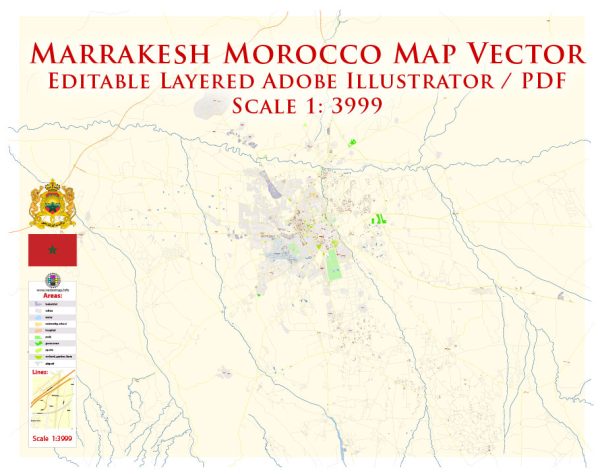Marrakesh, Morocco, is renowned for its unique and captivating architecture, which reflects a rich history of cultural influences. Here is a description of Marrakesh’s architecture:
- Moorish and Islamic Influence: Marrakesh’s architectural style is predominantly influenced by Moorish and Islamic design principles. These elements are characterized by intricate geometric patterns, arches, and the extensive use of zellige tilework. The city’s architecture is a testament to the Islamic architectural tradition, which emphasizes the use of decorative details to create visually stunning structures.
- Medina: The historic heart of Marrakesh is the Medina, a UNESCO World Heritage site. It’s a walled city with a labyrinthine layout of narrow, winding streets. Buildings in the Medina are typically constructed with reddish-pink clay, giving them a warm and earthy tone. The buildings are adorned with traditional wooden balconies and intricately designed doors.
- Riads: Marrakesh is famous for its riads, traditional Moroccan houses with interior courtyards or gardens. Riads are designed to provide a peaceful oasis in the midst of the bustling city. They often feature lush gardens, fountains, and mosaic-tiled courtyards. The architecture of riads is a harmonious blend of Islamic and Andalusian influences.
- Kasbahs: Outside the Medina, you can find kasbahs, which are traditional fortified structures. The Kasbah of the Udayas is a well-known example in Marrakesh, showcasing the defensive architectural style of the region with its crenellated walls, narrow alleys, and striking gateways.
- Mosques and Minarets: Marrakesh boasts numerous beautiful mosques and minarets, many of which are off-limits to non-Muslims. The Koutoubia Mosque, with its iconic minaret, is one of the city’s most recognizable landmarks. The minarets are often adorned with ornate tilework and offer stunning examples of Islamic architecture.
- Palaces and Gardens: The city is home to several opulent palaces and gardens, such as the Bahia Palace and the Saadian Tombs. These structures showcase the grandeur of Moroccan architecture with their intricate stucco work, mosaic tiles, and lush green spaces.
- Madrasas: Marrakesh is home to several historic madrasas, Islamic schools of learning. The Ben Youssef Madrasa is a prime example, featuring stunning tilework, stucco plaster, and calligraphic inscriptions.
- Souks and Bazaars: The souks and bazaars of Marrakesh are a vibrant blend of architecture and commerce. Covered marketplaces with arched entrances and narrow lanes create a unique shopping experience. The stalls are often adorned with colorful textiles and crafts.
- Modern Architecture: In recent years, Marrakesh has seen the development of modern architecture, especially in the newer parts of the city. These structures often incorporate traditional elements into contemporary designs, creating a harmonious blend of old and new.
Marrakesh’s architecture is a testament to its rich cultural heritage and the enduring influence of Islamic and Moorish design traditions. The city’s unique blend of historic and contemporary elements creates a captivating visual experience for visitors.


 Author: Kirill Shrayber, Ph.D.
Author: Kirill Shrayber, Ph.D.